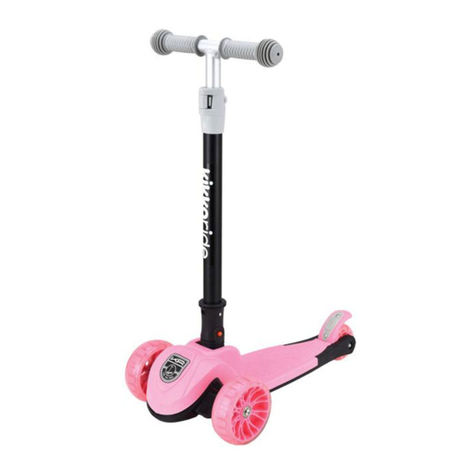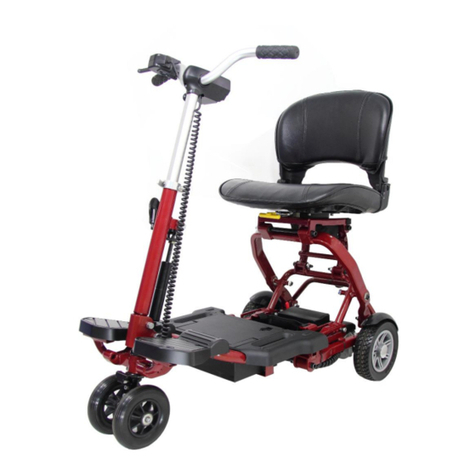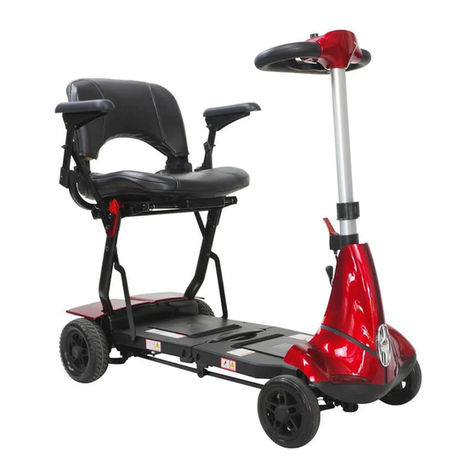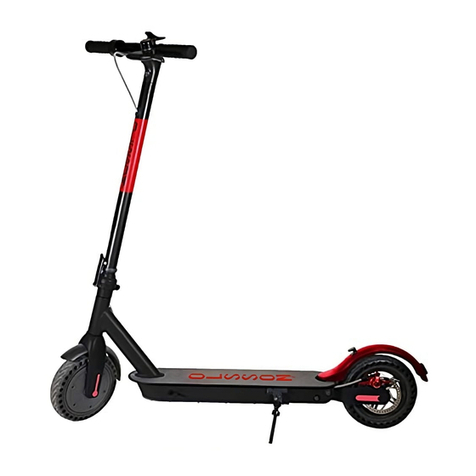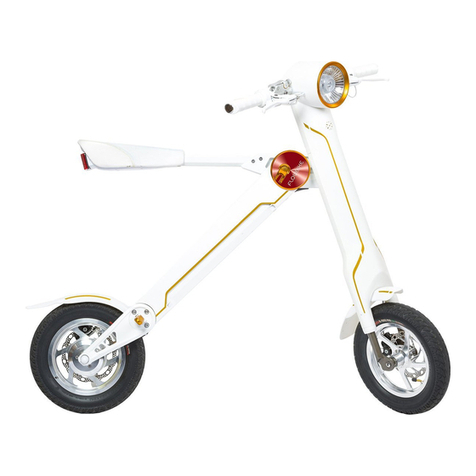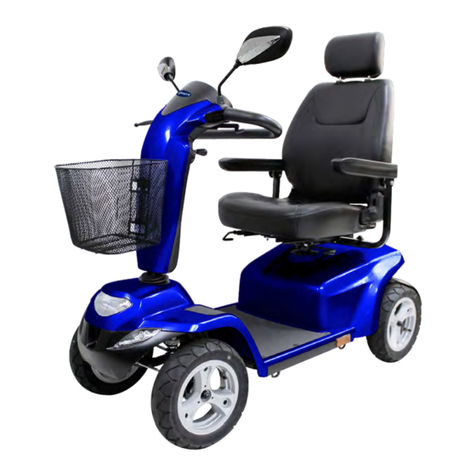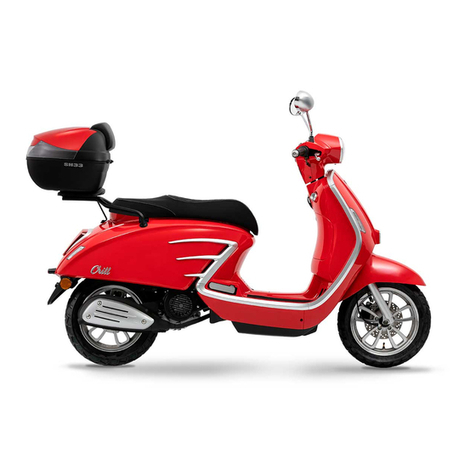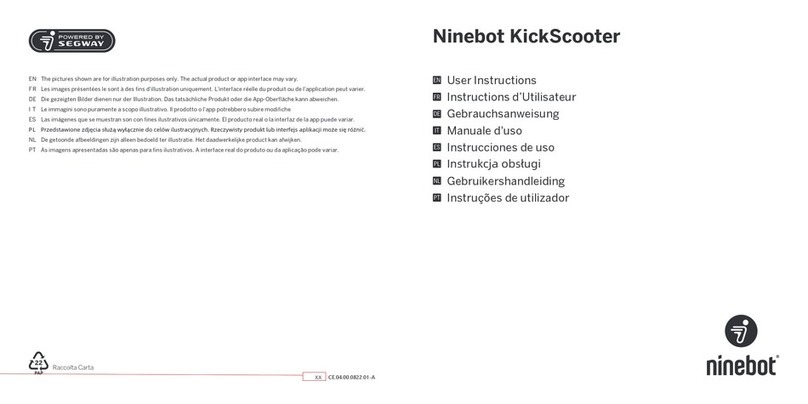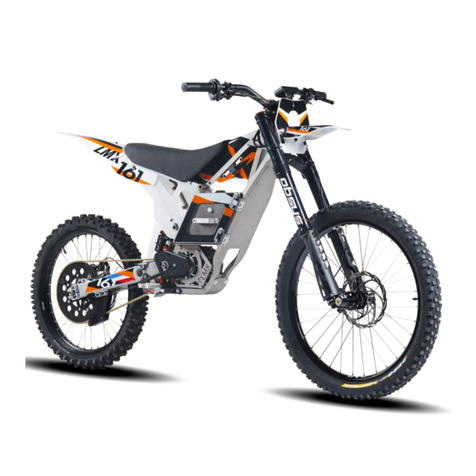Golden Buzzaround Carry On User manual

Buzzaround Carry On
Service Guide
This Service Guide contains:
Troubleshooting
Replacement Instructions
Multi-meter Instructions
Model: GB120

2

3
Table of Contents
Nomenclature and Contact Information.........................................................................................4
ABOUT THE BUZZAROUND CARRY ON SERVICE GUIDE.......................................................5
Buzzaround Carry On Components..........................................................................................5-10
Wiring Diagram............................................................................................................................11
SCENARIO 1: Turn the key to the on position and no power......................................................12
SCENARIO 2: Battery Pack will not charge.................................................................................13
BEEP/FLASH CODES............................................................................................................14-17
BEEP/FLASH CODE #1 - Battery Pack Low (Scooter may drive slowly)....................................14
BEEP/FLASH CODE #2 - Battery Pack Low (Scooter will not operate)......................................14
BEEP/FLASH CODE #3 - High Battery Voltage..........................................................................14
BEEP/FLASH CODE #4 - Current Limit Timeout.........................................................................14
BEEP/FLASH CODE #5 - Brake Fault.........................................................................................15
BEEP/FLASH CODE #6 - Paddle Fault (out of neutral)...............................................................15
BEEP/FLASH CODE #7 - Paddle Fault/Speed Control Fault (voltage error).........................16-17
BEEP/FLASH CODE #8 - Motor Voltage Fault (Open/Shorted)..................................................17
BEEP/FLASH CODE #9 - Controller Fault...................................................................................17
BUZZAROUND CARRY ON REPLACEMENT INSTRUCTIONS...........................................18-23
Drive Wheel..................................................................................................................................18
Anti Tip……..................................................................................................................................18
Throttle Pot...................................................................................................................................18
Battery Pack.................................................................................................................................19
Fuses......................................................................................................................................19-20
Controller......................................................................................................................................20
Dash and Dash Components………………………………....………………………………………..21
Upper Main Harness....................................................................................................................21
Transaxle Assembly.....................................................................................................................22
Lower Main Harness……………………………………………………………………………..……...22
Steering Assembly………………………………………………………………………………………23
Tiller Shock………………………………………………………..……………………………………..23
APPENDIX A - HOW TO USE A VOLTMETER...........................................................................24
APPENDIX B - HOW TO USE AN OHM METER........................................................................25

4
BUZZAROUND CARRY ON NOMENCLATURE
Figure 1. Buzzaround Carry On (Model GB120)
1
2
3
10
4
5
6
7
8
9
11
12
13
14 15
16
1 - Seat
2 - Arm Assembly
3 - Seat Plate
4 - Seat Pedestal
5 - Tiller Assembly
6 - Lithium Ion Battery Pack
7 - Drive Train
(Transaxle, Motor, Brake)
8 - Controller (located under cover)
9 - Steering Assembly
10 - Front Wheel
11 - Rear Wheel (Drive)
12 - Freewheel Switch
13 - Dash (Upper/Lower)
14 - USB Board (Inside)
15 - Bottle Holder
16 - Hand Grip
17 - Tiller Adjustment Lever
18 - Paddle (Throttle Lever)
19 - LED Head Light
20 - LED Tail Light
21 - Deck (Upper/Lower)
17
18
19
Contact Information
Golden Technologies
401 Bridge Street
Old Forge, PA 18518
Toll-free: 800-624-6374
Mobility Tech: x501
Lift Chair: x502
VA Tech: x505
Fax: 800-628-5165
Email: [email protected]
20
21

5
This service guide provides you with the information necessary to troubleshoot the Golden Technologies
Buzzaround Carry On GB120. The troubleshooting scenarios in this manual consist of procedures that
enable you to systematically trace and correct faults in the system. Appendices A and B include instructions
on how to measure voltage and continuity with a multimeter.
Before troubleshooting, check the following:
Make sure the battery pack is seated securely.
Visually check terminals for corrosion. Check wires for missing insulation.
Make sure there are no blown fuses.
Make sure that the battery pack is fully charged and in good working order. When possible, keep a
known good battery pack in your shop at all times. The Buzzaround Carry On uses (1) 15AH or
6.5AH Lithium Ion battery pack. Problems that surface during troubleshooting are often due to the
fact that the battery pack is not fully charged or can not hold a charge.
Make sure that the electrical connections are secure. Unplug the connectors and make sure all the
pins in the connectors are seated securely. If necessary, push any unseated pins back into their
connector housings to securely seat them.
If you get to a point during troubleshooting where you cannot continue, call
Technical Support at 800-624-6374.
BUZZAROUND CARRY ON COMPONENTS
The Buzzaround Carry On is a battery-operated scooter with a controller that monitors the system and
flashes/beeps when it detects a fault in the system. The Buzzaround Carry On was designed to operate within
a range of between 22V– 30.8V (Volts) of direct current (DC).
The Buzzaround Carry On control system is made up of the components listed below.
Each of these components is designated by its assigned number. Refer to the wiring diagram on page 11.
• 24V Lithium Ion Battery Pack - #1
• Battery Harnesses - #2
• Motor Harness - #3
• Dynamics R-Series Controller - #4
• Main Harness - upper/lower - #5
• Motor/Brake Assembly - NA
• Dash (Upper/Lower) - NA, see console board- #7
Note: includes Throttle Pot- #8, Speed Pot - #9, Key Switch - #10, Horn Button, Light Switch, and
Battery Meter
• XLR Charging Ports - One located on the tiller and one on the bottom side of the battery pack. - NA
• USB Charging Ports - One located on the tiller and one on the bottom side of the battery pack. - NA
Note: See Charger Harness - #11
• Off-Board Battery Charger - NA
Note: NA - Not Applicable
Parts and service must be authorized by the Golden Technologies Service
Department. Unauthorized parts or service may void the warranty. For more information, contact the

6
Component: 1-24VDC Lithium Ion Battery Pack (15AH or 6.5AH) - #1
Location: Center of the upper deck. See figure 2.
Function: Supply 24-29VDC to the motor and/or accessories.
Connections: Connected by two spr ing loaded connectors at the r ear
of the battery pack and a push-button latch at the front of the battery pack.
Failure Signs: Batter ies dr ain quickly. Scooter r uns slowly or not at all.
Batteries will not charge, but charger is working properly. Beep Code #1 or #2.
Tests: Fully charge the batter y pack first and load test. Make sur e the contacts
are not corroded.
Expected Reading: 24-29VDC when fully charged.
Serviceable: Replace batter y pack as necessary.
Component: Battery Harness - #2 Figure 2. Lithium Ion Battery Pack
Location: Inside the plastic upper/lower body halves.
Function: Connects the batter y (1) to the contr oller (4), and
the control board inside the scooter deck.
Provides short circuit protection through a 35-amp inline fuse,
located inside the controller cover.
Connections: Connected to the batter y (Bat -) and (Bat +),
controller (Bat -) and (Bat +), control board, and battery fuse.
Refer to the wiring diagram on page 11.
Failure Signs: Open fuse, cor r oded wir es, poor
connections, and poor spring tension can cause the battery
voltage (24-29 volts) not to be supplied to the entire electrical
system.
Make sure the fuse is good, and all connections are good.
Note: Battery pack will not charge if the inline fuse is blown.
Tests: Test the fuse for continuity. Test the har ness for
continuity. See figure 3. Refer to the wiring diagram on
page 11.
Expected Readings: Less than 10 ohms.
Serviceable: Replace the har ness as necessar y.
Replace inline fuse with exact type and rating. Refer to the
wiring diagram on page 11. Figure 3. Battery Harness
Component: Motor Harness - #3
Location: Rear of the scooter – Inside the plastic
upper/lower body halves. See figure 4. Refer to the
wiring diagram on page 11.
Function: Supplies 24-29 volts from the controller to
the motor.
Connections: Controller (M+) and (M-) and the motor.
See figure 4. Refer to the wir ing diagram on page 11.
Failure Signs: Scooter will not run. The motor is not
receiving the correct 24-29 volt battery voltage from the
controller.
Tests: Test har nesses for continuity. Check connectors.
Make sure the contacts are not corroded and are seated
properly.
Expected Readings: Continuity (less than 10 ohms). Figure 4. Motor Harness (hard wired into motor)
Serviceable: Replace as necessar y.

7
Figure 5. Controller
Component: Contr oller - #4
Location: Mounted inside the deck under the removable contr oller cover. See figure 5.
Function: Contr ols and monitors the system. Uses a ser ies of beeps/flashes when something in the system is out
of range.
Connections: Connected to the main harness (5), char ger & inhibit, br ake, motor (M-M+), battery (B-B+). See
figure 3. Refer to the wiring diagram on page 11.
Failure Signs: Beep Code #9. No power to the control panel or the motor .
Tests: Test for voltage coming into and out of the controller.
Expected readings: Battery voltage (24-29VDC).
Serviceable: Replace as necessar y.
Component: Main Har ness - #5
Location: Inside the dash and the plastic upper/lower body halves. See figures 5 and 6. Refer to the wiring
diagram on page 11.
Function: Provides connectivity for the tiller components and the contr oller.
Connections: Connected to the contr oller , and contr ol panel. Refer to the wiring diagr am on page 11.
Failure Signs: Scooter will not run.
Tests: Test for voltage and continuity. Check connectors. Make sur e the pins ar e not corr oded and are seated
properly.
Expected readings: Battery voltage (24-29VDC). Continuity (less than 10 ohms).
Serviceable: Replace as necessar y.
Figure 6. Main Harness (Shown Separated)
Main
Harness
Charger & inhibit
Brake
M-
M+
Bat-
Bat+
Fuse
Spare Fuse
UPPER HARNESSLOWER HARNESS

8
Component: Brake Harness - #6
Location: Fr om the brake to the contr ol board. See figure 7.
Function: Provides connectivity between the br ake and the
freewheel switch.
Connections: CN4 on the contr ol boar d. Refer to the wiring
diagram on page 11.
Failure Signs: Scooter faults and will not move.
Tests: Test for voltage and continuity. Check connectors.
Make sure the pins are not corroded and are seated properly.
Expected readings: Continuity (less than 10 ohms).
Serviceable: Replace as necessar y.
Component: Console Board - #7 Figure 7. Control Board
Location: Mounted inside the dash. See figure 8.
Function: Provides connectivity for the main harness,
key switch, speed pot, throttle pot, battery meter, on/off
switch, horn, and horn button.
Connections: Connections CN1 - CN8. Refer to the
wiring diagram on page 11.
Failure Signs: Scooter faults, will r un slowly or
not at all.
Meter and/or horn does not function.
Tests: Test for voltage and continuity. Check
connectors.
Make sure the contacts are not corroded.
Expected readings: Continuity (less than 10 ohms).
Serviceable: Replace as necessar y. Figure 8. Console Board
Component: Throttle Pot (Potentiometer) - #8
Location: Below the control panel. See figure 9.
Function: The thr ottle pot uses variable r esistance
to control speed and direction of travel by varying voltage.
Connections: CN7 on the console board. Refer to the wiring
diagram on page 11.
Failure Signs: Beep Codes #6 and #7.
Tests: Test resistance across pins 1, 2, and 3 on the thr ottle pot.
Expected readings: Depends on dir ection of deflection.
Serviceable: Replace as necessar y.
Component: Speed Pot (Potentiometer ) - #9
Location: Mounted on the control panel. See figure 10.
Function: The speed pot uses var iable resistance to control
the speed of the scooter.
Connections: CN8 on the console board. Refer to the wiring Figure 9. Throttle Potentiometer
diagram on page 11.
Failure Signs: Beep Code #7
Tests: Call Tech Support
Expected readings: Depends on speed pot position.
Serviceable: Yes. Replace the speed pot.
Figure 10. Speed Pot
CN4

9
Component: Key Switch - #10
Location: Mounted on the control panel. See figure 11.
Function: Completes the cir cuit to pr ovide power to
the motor.
Connections: CN2 on the console board. Refer to the
wiring diagram on page 11.
Failure Signs: No power when the key is in the
“ON” position.
Tests: Continuity when the key is in the “ON” position. Figure 11. Key switch
Make sure the connector pins are seated properly.
Expected readings: Less than 10 ohms.
Serviceable: Yes. Replace the key switch.
Component: Charger Har ness - #11
Location: Inside of the tiller below the contr ol panel.
See figure 12.
Function: Supplies voltage to the USB port and allows the
battery pack to be charged through the tiller XLR port.
Connections: Connected to the USB boar d, tiller fuse, and
tiller XLR charging port. See figure 12. Refer to the wiring
diagram on page 11.
Failure Signs: Batter y pack will not char ge thr ough the tiller
XLR port, and USB port does not function.
Tests: Test for voltage and continuity. Check connectors.
Make sure the pins are not corroded and are seated properly.
Expected readings: Battery voltage (24-29VDC).
Continuity (less than 10 ohms).
Serviceable: Replace the har ness as necessar y.
Figure 12. Charger Harness
Component: Motor/Brake Assembly - NA
Location: Mounted on the transaxle. See figure 13.
Function: Drives the scooter .
Connections: Connected to the contr oller ,
control board, and the transaxle.
Refer to the wiring diagram on page 11.
Failure Signs: Scooter r uns slowly or not at all.
Tests: Test for internal r esistance in motor . Test
motor wires for continuity. See Beep Codes #5 and #8.
Expected readings: Internal motor resistance is
0.8 ohms – 1.5 ohms. Brake resistance is
45 ohms – 52 ohms.
Serviceable: Replace the complete tr ansaxle assembly.
Component: Brake - NA
Location: Mounted on the end of the motor. Figure 13. Complete Transaxle Assembly
See figure 13.
Function: Keeps the motor from moving when
the power is off.
Connections: Connected to CN4 on the contr ol boar d through the br ake harness (6). Refer to the wiring
diagram on page 11.
Failure Signs: Scooter r uns slowly or not at all.
Tests: Test for internal r esistance. See Beep Code #5.
Expected readings: Brake resistance is 45 ohms – 52 ohms.
Serviceable: Replace the complete tr ansaxle assembly.
Transaxle
Motor Brake

10
Component: Off-Board Charger - NA, (Not shown)
Location: Stor ed inside a pouch on the seatback.
Function: Char ges the batter y pack.
Connections: Connects to the XLR char ger port on the tiller or back side of the batter y pack. Refer to the
wiring diagram on page 11.
Failure Signs: Char ger power LED does not go on. Batteries will not char ge.
Tests: Measure voltage across (B-) a black wire and (B+) a red wire on the controller (4) battery terminals.
While observing the voltage reading, plug the charger into the wall outlet and make sure the voltage reading increases.
Expected readings: Battery voltage (24-29VDC) first, approximately 29 volts when fully charged. Also, refer to the
charger test on page 13. Test charger harness and fuse for continuity.
Serviceable: Replace if necessar y.
Only use the charge that was supplied with the scooter. The charger was specifically
designed and tested for the product it came with.

11
Motor Harness (3)
(5)
Figure 14. Buzzaround Carry On Wiring Diagram
(8)
(9)
(10)
Charger Harness (11)
Dynamic R-Series
Controller (4) 24 Volt Battery Pack (1)
Battery Harnesses (2)
Brake Harness (6)
(5)
14-Pin
Connector
(7)

12
SCENARIO 1: TURN THE KEY TO THE ON POSITION AND NO POWER
Put the key into the key switch and turn to the on position. There is no power to the dash. The horn does not work and
the battery condition meter does not work. Battery voltage travels from the battery, through the controller and the key
switch. The test below will verify that there is battery voltage at the battery, the controller, the main harness, and the
key switch. Make sure that the battery is fully-charged and connected properly. You can also refer to the wiring
diagram on page 11. If the batteries will not charge, go to “Scenario 2: Batteries will not charge.”
If you are unsure of the correct way to measure
voltage or resistance, refer to Appendix A and B in this manual
before proceeding.
Check Battery Voltage at the Battery pack.
1. Remove the battery pack.
2. Measure voltage across the two inside terminals on the battery
pack. See figure 15.
• 24-29VDC (or battery voltage on pack?) - Go to the next step.
• More than 22VDC on pack? - Try to recharge the batteries.
Load test and replace if necessary.
• 0VDC? - Replace the battery pack.
Check Voltage Into the Controller.
3. Make sure the battery pack is installed.
4. Remove the two thumb screws directly below the seat to remove the
controller cover.
5. Measure voltage across the red B+ and black B- wires on the controller.
See figure 16.
• 24-29VDC (or battery voltage?) - Go to the next step.
• 0VDC? - Check the 35A fuse for continuity, battery harness for
continuity. Replace as necessary.
Check Voltage Out of Controller.
6. Make sure the red B+ and black B- wires are connected to the controller.
7. Remove the red M+ and black M– wires from the controller.
See figure 17.
8. Measure voltage across the M+ and M– terminals of the controller.
• 24-29VDC (or battery voltage?) - Go to the next step.
• 0VDC? - Replace the controller.
Check Voltage at Main Harness.
9. Measure voltage across pin 1 and pin 2 of the XLR port on the tiller.
• 24-29VDC (or battery voltage?) - Go to next step.
• 0VDC? – Check the tiller fuse for continuity. No continuity? –
Replace the 3 amp fuse. Refer to the wiring diagram on page 11.
Continuity? - Go to the next step.
10. Open the dash.
11. Disconnect the red key switch harness from the console board (7).
12. Measure voltage across the two pins of connector (CN2). Refer to the
wiring diagram on page 11.
• 24-29VDC (or battery voltage?) - Check continuity across the
key switch. No continuity? – Replace key switch.
Continuity? - Replace the console board.
• 0VDC? - Replace the main harness (5).
Red +
Figure 16.
Red +
Red +
Figure 17.

13
SCENARIO 2: BATTERY PACK WILL NOT CHARGE
The battery charger needs to “see” at least 22VDC at the charger port. Otherwise, it may not send a charging
current to the batteries. This test will ensure that the battery voltage is making it to the charger port., and that the
battery pack is working properly.
If you are unsure of the correct way to measure voltage or resistance, refer to Appendix A and
B in this manual before proceeding.
Check Battery Charger Voltage.
1. Open the tiller XLR port and check the voltage across pin 1 and pin 2.
See figure 18. Refer to the wir ing diagr am on page 11.
• 24-29VDC (or battery voltage on pack?) - Go to the next step.
• More than 22VDC on pack? - Try to recharge the battery pack.
Load test and replace if necessary.
• 0VDC? - Replace the battery pack.
2. Open the controller cover directly under the seat.
3. Plug the charger into the XLR charger port and then into a wall outlet.
4. Measure voltage across the B+ and B- connections on the controller (4).
See figure 19. Refer to the wir ing diagr am on page 11.
Does the voltage increase?
• Yes? - Load test the batteries and replace as necessary.
• No? - But there is voltage. If the voltage is lower than 22VDC, then replace the batteries. If the voltage is 22VDC
or greater, then replace the charger.
Figure 19. Controller B+ and B- Connections
Figure 18. Tiller XLR Charger Port
Red +
Red +

14
BEEP/FLASH CODES
The controller uses audible beeps/flashes to indicate the status of the system. When the controller notices that there is
a malfunction in the system, it will beep/flash a code when the power is on. For example, when it beeps/flashes five
times and stops that indicates beep/flash code #5 – Brake Fault.
The following beep/flash codes are used to help diagnose system errors:
Beep/Flash Code #1 – Battery Pack Low (Scooter will operate)
Beep/Flash Code #2 – Battery Pack Very Low (Scooter will not operate)
Beep/Flash Code #3 – High Battery Voltage
Beep/Flash Code #4 – Current limit timeout
Beep/Flash Code #5 – Brake Fault
Beep/Flash Code #6 – Paddle Fault (out of neutral)
Beep/Flash Code #7 – Throttle Pot/Speed Pot Fault
Beep/Flash Code #8 – Motor Voltage Fault (Open/Shorted)
Beep/Flash Code #9 – Controller Fault
If you are unsure of the correct way to measure voltage or resistance, refer to Appendix A and B
in this manual before proceeding.
BEEP/FLASH CODE #1 - BATTERY PACK LOW (SCOOTER MAY DRIVE SLOWLY)
This Beep/Flash Code occurs when the battery voltage drops below a certain level. Recharge the battery Pack
immediately. If the battery pack will not recharge, then load test it or refer to “Scenario 2: Battery Pack will not
Charge”, on page 13.
BEEP/FLASH CODE #2 - BATTERY PACK LOW (SCOOTER WILL NOT OPERATE)
This Beep/Flash Code occurs when the battery voltage drops lower than Beep Code #1. Recharge the battery pack
immediately. If the battery pack will not recharge, load test it or refer to “Scenario 2: Battery Pack will not
Charge”, on page 13.
BEEP/FLASH CODE #3 - HIGH BATTERY VOLTAGE
This Beep/Flash Code occurs when the battery voltage climbs above 29.6VDC.
1. Insert the key into the key switch and turn it to the on position. Allow the battery level to drop. Do not allow the
battery voltage to fall into the red area on the battery meter.
2. Check the battery charger. Make sure it is an approved charger.
BEEP/FLASH CODE #4 - CURRENT LIMIT TIMEOUT
This Beep/Flash Code occurs when the motor has been exceeding its maximum current rating for too long. This may
be due to a faulty motor, poor battery condition, excessive uphill driving, or excessive weight. First turn off the scooter
and allow it to cool for ten minutes. If this does not work, use the following procedure.
Inspect the Following Connections:
Motor Harness (3), Brake Harness (6), (M+M–) Controller Connections, and Control Board (CN4) Connection.
1. Remove the battery pack.
2. Inspect the motor/brake assembly, control board connector (CN4), and
controller (4). Is there visible damage, discolored or melted wires?
Refer to the wiring diagram on page 11.
• Yes? - Replace the complete transaxle/motor/brake assembly
or brake harness as necessary.
• No? - Go to the next step.
Check Motor Resistance at Motor.
3. Remove the (M+ M-) connectors from the controller (4).
4. Measure resistance across the red M+ and black M- connectors.
(Internal resistance of the motor). See figure 20.
• 0.8 ohms – 1.5 ohms but not shorted? – Go to the next step.
• Out of that range, or open? – Replace the complete
transaxle/motor/brake assembly.
Figure 20. Controller M+ and M- Connections
M-
M+
Red +

15
BEEP/FLASH CODE #5 - BRAKE FAULT
This Beep/Flash Code occurs because the park brake release switch is active or the park brake may be faulty.
Check the Park Brake Position
1. Turn the key to the off position.
2. Disengage and then re-engage the park brake.
3. Turn the key to the on position. Did the beep code clear?
• Yes? - OK.
• No? - Go to the next step.
Check Resistance at the Brake.
4. Remove the battery pack.
5. Separate the brake harness (6) and measure resistance (with the park
brake engaged) acr oss the two pur ple wires coming fr om the brake.
See figure 21. Refer to the wir ing diagram on page 11.
• 45 ohms – 52 ohms? – Replace the controller.
Note: If you have replaced the controller and the fault persists, Figure 21. Connection from Brake
go to step 6 below.
• Out of range? – Replace the complete transaxle/motor/brake
assembly.
• Shorted or open? – Replace the complete transaxle/motor/brake
assembly.
Check Park Brake Resistance at the Controller.
6. Remove the two screws securing the controller.
7. Lift the controller to expose the control board underneath it.
8. Measure continuity across the purple brake harness CN4 and
yellow brake harness CN3. See figure 23. Refer to the wiring
diagram on page 11.
• Continuity?
Yes - Replace the control board.
No - Replace harness(es) as needed.
Figure 22. Connection from Brake
BEEP/FLASH CODE #6 - PADDLE FAULT (OUT OF NEUTRAL)
This Beep/Flash Code means that the throttle control lever was not
in the neutral position when the key is turned to the on position.
1. Turn the key to the off position.
2. Make sure that the paddle pot is not obstructed and it can
return to the neutral (center) position.
3. Move the throttle pot forward and then reverse. Make sure that
it is not obstructed. Does it spring back to the neutral position?
• Yes? – Go to the next step.
• No? – Check for obstructions. Adjust if necessary. Replace if
the adjustment does not work or if there are no obstructions.
4. Turn the key to the on position. Does the code return?
• No? – OK
• Yes? – Go to Beep CODE #7 to test the paddle pot. Figure 23. Control Board
CN3 CN4

16
BEEP/FLASH CODE #7 - THROTTLE POT/SPEED CONTROL FAULT
This Beep/Flash Code occurs because there is a fault with the throttle pot,
speed pot, or the associated wiring.
Check Throttle Pot Resistance at Controller.
1. Remove the battery pack.
2. Remove the controller panel by loosening the (2)
thumb screws on the scooter deck directly below the seat.
3. Turn the speed pot to full rabbit.
4. Set your multimeter to measure resistance.
5. Disconnect the main harness (5) from the
controller (4). Refer to the wiring diagram on page 11.
6. Insert multimeter probes into the main harness
connector at pin 2 and pin 8 (light green wire and white wire).
See figure 24.
• 5k ohm ±10%? – Replace the controller.
• Outside that range? - Go to the next step.
7. Insert the multimeter probes into the main
harness connector 5 at pin 1 and pin 8
(yellow wire and white wire). See figure 25.
Note the resistance reading. Insert the multimeter probes
into the main harness connector 5 at pin 1 and pin 2
(yellow wire and light green wire). See figure 26.
Note the resistance reading.
• Are both readings within 500 ohms of each
other? - Replace the controller.
• Are either of the readings outside that range? - Go
to the next step.
Check Throttle Pot Resistance at Throttle Pot.
8. Separate the lower dash from the upper dash.
9. Disconnect the throttle pot harness (CN7) from
the console board (7). Note: This is a white connector
with three wires, blue, yellow, and orange.
Refer to the wiring diagram on page 11.
10. Insert the multimeter probes into the throttle pot
connector (CN7) at the blue wire and the orange
wire (outside two pins). See figure 27.
• 5k ohm ±10%? - go to the next step.
• Outside that range? - Replace the throttle pot.
Figure 24. Connector, Pins 2 and 8
Figure 25. Connector, Pins 1and 8
Figure 26. Connector, Pins 1 and 2
Figure 27. Connector, CN7

17
11. Insert the multimeter probes into the throttle pot
connector (CN7) at the yellow wire and the orange wire.
See figure 28. Note the r esistance reading.
Insert the multimeter probes into the
throttle pot connector (CN7) at the yellow wire
and the blue wire. See figure 29. Note the resistance reading.
• Are both readings within 500 ohms of
each other? - Go to the next step.
• Are either of the readings outside that
range? – Replace the throttle pot.
12. Check the light green, yellow, and white wires on
the main harness (5) for continuity.
• 10 ohms or less on each one? - Replace the
speed pot.
• Open on any wire? - Replace the main harness.
BEEP/FLASH CODE #8 - MOTOR VOLTAGE FAULT
(OPEN)
This Beep/Flash Code occurs when there is an internal problem
with the motor or its wiring.
Check Motor Resistance at Motor.
1. Remove the battery pack.
2. Remove the controller panel by loosening the (2)
thumb screws on the scooter deck directly below the seat.
3. Disconnect the (M- and M+) connections from the controller.
Refer to the wiring diagram on page 11.
4. Measure the (internal resistance of the motor), across
(M- and M+). See figure 30.
• 0.8 ohms – 5 ohms? – Replace the controller.
• Out of range? – Replace the complete transaxle assembly.
• Open? – Replace the complete transaxle assembly.
• Shorted? – Replace the complete transaxle assembly.
BEEP/FLASH CODE #9 - CONTROLLER FAULT
This Beep/Flash Code means that the controller has an internal
fault.
1. Remove the key from the key switch and allow
the controller to cool down. If the code continues,
then replace the controller.
Figure 28. Connector, CN7
Figure 29. Connector, CN7
Figure 30. Controller, M- M+ Connections

18
BUZZAROUND CARRY ON REPLACEMENT INSTRUCTIONS
DRIVEWHEEL REPLACEMENT
Tools needed: 5mm Allen wrench, small straight screwdriver.
1. Place the freewheel lever into the engaged position.
2. Remove the key from the key switch.
3. Place the rear of the scooter onto blocks.
4. Remove the center cap.
5. Remove the bolt and washer that fasten the wheel to the axle.
Make sure you retain the axle key. See figure 31.
6. Place a new wheel onto the axle. Make sure that the
axle key is reinstalled in its original position.
7. Reinstall the hardware removed in step 5 and tighten securely.
8. Reinstall the center cap.
ANTI TIP REPLACEMENT
Tools needed: 13mm Socket, Phillips screwdriver.
1. Place the freewheel switch in the engaged position.
2. Remove the key from the key switch.
3. Remove the seat.
4. Remove the battery pack.
5. Stand the scooter up as shown. See figure 32.
Tip Hazard! Make sure the scooter is
stable before attempting any repairs.
6. Remove the left or right anti tip assembly, by
removing the (1) lock nut and (1) Phillips screw shown
inside the small circles. See figure 32.
7. Install the new anti tip assembly by reversing
steps 1-6.
Note: If needed, repeat step 6 for the opposite side.
THROTTLE POT REPLACEMENT
Tools needed: Phillips screwdrivers, 7mm socket
1. Place the freewheel lever in the engaged position.
2. Remove the key from the key switch.
3. Remove the battery pack from the scooter.
4. Separate the upper and lower dash halves by removing the (7)
Phillips screws. See figure 33. Refer to figure 37 on page 21.
5. Unplug the throttle pot (8) harness from (CN7) on the console board.
6. Remove the (2) nut and bolts that fasten the throttle pot assembly.
7. Reverse steps 1-6 to reassemble.
Figure 31. Drive Wheel Axle Key
Figure 33. Throttle Pot
Figure 32. Anti Tip Assemblies

19
BATTERY PACK REPLACEMENT
Tools needed: None
1. Place the freewheel lever in the engaged position.
2. Remove the key from the key switch.
3. Press the release lever in front of the battery pack on the scooter deck.
4. Remove the battery pack. See figure 34.
5. Insert the new battery pack, and press down to lock it into place.
DO NOT ATEMPT TO OPEN THE BATTERY PACK.
THE BATTERY PACK AND ITS COMPONENTS ARE NOT SERVICEABLE.
Figure 34. Battery pack (Top side)
FUSE REPLACEMENT
Non-Flash/Beep Code Faults
If the following faults occur, please check the appropriate fuses located inside the controller panel or at the center of
the tiller. Refer to figures 35 and 36 on page 20 for fuse replacement and warnings.
3AMP Mini Glass Fuse shown
Good Fuse Bad Fuse
Fault
The XLR charging port is not functioning, causing the battery pack not to charge when the off-board battery
charger is connected.
Remedy: Check the fuse (F3AL250V) inside the fuse holder located on the tiller below the contr ol panel.
Replace the fuse with the same type and rating if the fuse is bad.
FUSES MUST BE REPLACED WITH SAME TYPE AND RATING.
35AMP Blade Style Fuse shown
Good Fuse Bad Fuse
Faults
The dash does not illuminate when the key is turned to the “on” position. The scooter does not operate and the
headlight/taillight do not illuminate.
The USB charging port will not charge your smart devices such as a phone or tablet.
Remedy: Check the fuse (35 AMP) inside the power module panel located directly under the seat. Replace the
fuse with the same type and rating if the fuse is bad.
Front
Back

20
FUSE REPLACEMENT - CONTINUED
3AMP MINI GLASS - TILLER FUSE REPLACEMENT
Tools needed: None
1. Remove the key from the key switch.
3. Remove the fuse cap by turning it counterclockwise. See figure 35.
4. Remove the bad fuse.
5. Install a new fuse, insert the cap, and twist the cap clockwise to secure.
35 AMP BLADE - CONTROLLER FUSE REPLACEMENT
Tools needed: None
1. Remove the key from the key switch.
2. Loosen the two thumb screws securing the controller Figure 35. Tiller Fuse (F3AL250V)
cover, by turning them counterclockwise.
3. Remove the cover to access the fuse. See figure 34.
4. Remove the bad fuse.
5. Install a new fuse, into the fuse holder.
Fuse(s) must be replaced with exact type
and rating. Refer to the wiring diagram on page 11.
CONTROLLER REPLACEMENT
Tools needed: Phillips Screwdriver
1. Place the freewheel lever in the engaged position.
2. Remove the key from the key switch.
3. Remove the battery pack from the scooter.
4. Loosen the two thumb screws securing the controller
cover, by turning them counterclockwise.
5. Remove the cover to access the controller. See figure 36.
6. Unplug all connections from the controller, noting their
locations. Refer to the wiring diagram on page 11.
7. Remove the (2) screws securing the controller. Figure 36. Controller
8. Remove the controller.
9. Install the new controller by reversing steps 1-8.
Wire placement is critical! Misplaced wires can cause damage to the controller and
associated wiring.
FUSE
CONNECTIONS
SCREW
SCREW
This manual suits for next models
1
Table of contents
Other Golden Scooter manuals

Golden
Golden Buzzaround Extreme GB118EX User manual
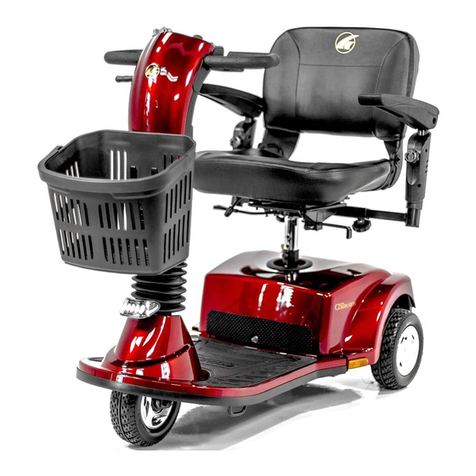
Golden
Golden GC240 User manual
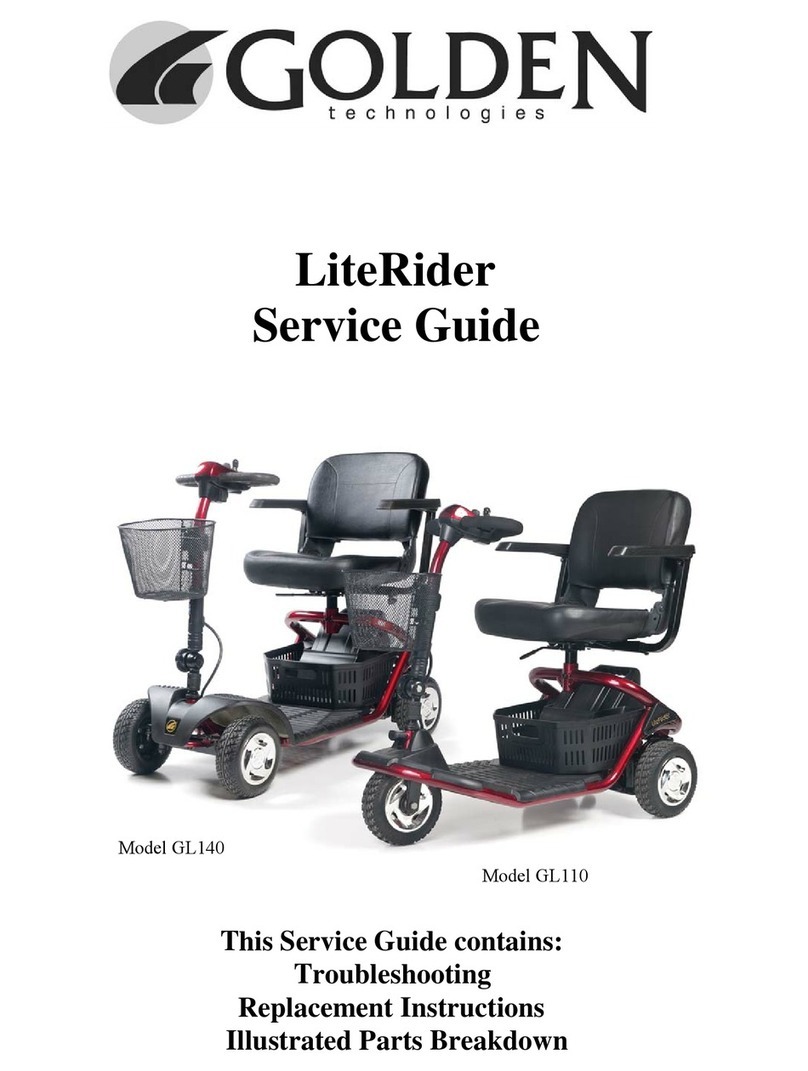
Golden
Golden LiteRider GL140 User manual
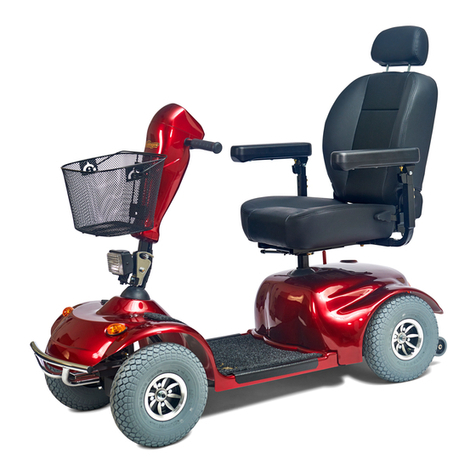
Golden
Golden Avenger GA541 User manual

Golden
Golden Buzzaround Lite User manual

Golden
Golden Companion II User manual

Golden
Golden GB-106XR Buzzaround Lite User manual
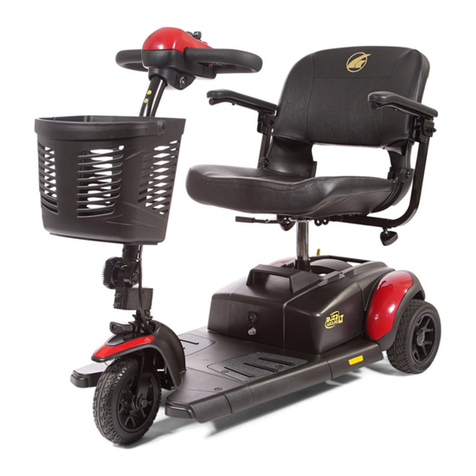
Golden
Golden Buzzaround XL Series User manual
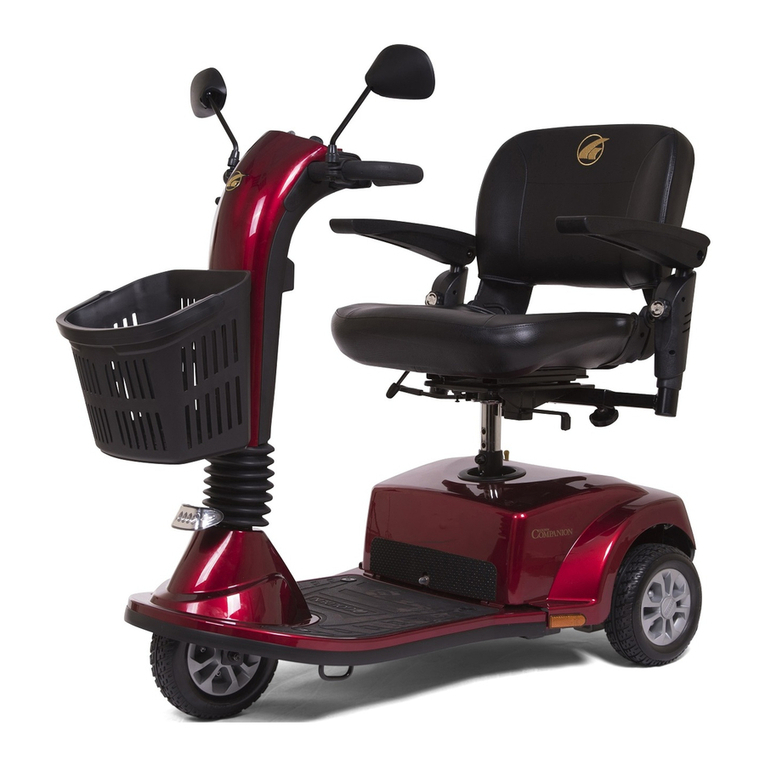
Golden
Golden Companion User manual
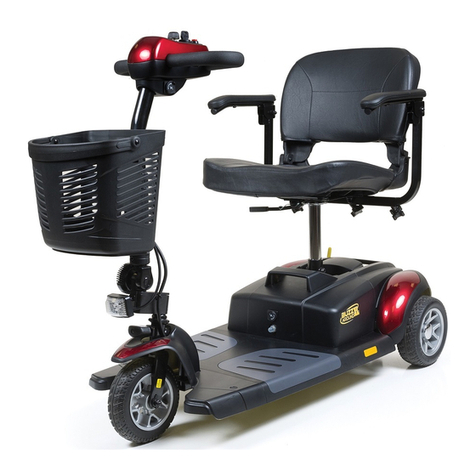
Golden
Golden Buzzaround XL GB117 User manual



